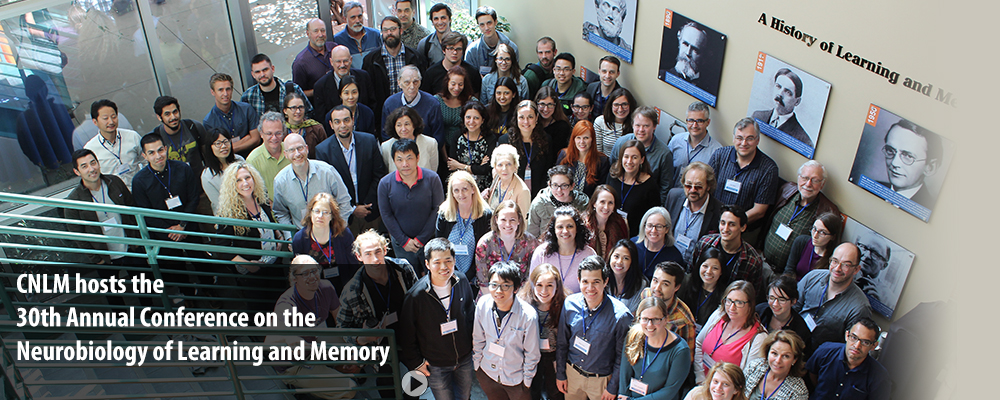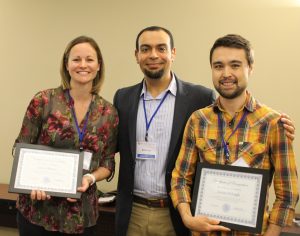CNLM Hosts the 30th Annual Conference on the Neurobiology of Learning and Memory
This month the Center for the Neurobiology of Learning and Memory hosted the 30th Annual Conference on the Neurobiology of Learning and Memory at the University of California, Irvine. The conference was attended by the Center’s Faculty Fellows, students, trainees and research scientists in addition to invited speakers from other institutions.
What makes some memories fleeting and others persistent? In 1890, William James suggested that memories, particularly emotional ones, can be so strong as to leave “a scar upon the cerebral tissues”. For centuries, the ability of salient experiences to leave behind persistent traces has captivated scientists and philosophers alike. While we now have a better understanding of the neural bases underlying the formation of many types of memory, the neural mechanisms of their persistence, and implications of this persistence for neuropsychiatric disorders have been subject to much debate. For example, it is not clear whether persistence and forgetting are active or passive processes at a physiological or biochemical level. Our understanding of how memory traces are transformed over time by repetition, rehearsal and reconsolidation (broadly defined) is also evolving and subject to conflicting views. The role of modulatory processes – including reward, stress, and fear – in making memories persistent is also a rapidly growing area of interest, with particularly important clinical implications. The 2017 Annual Meeting of the Center for the Neurobiology of Learning and Memory focused on this particular set of issues and facilitated a discussion of the state of the science, crucial unresolved questions, and experimental paths forward.
The conference featured three symposia that addressed this brand topic:
1. Persistence in rehearsal, retrieval and reconsolidation
2. Persistence of reward and addiction memories
3. Persistence of fear and stress memories
Day 1 of the conference began with a session titled “Persistence in rehearsal, retrieval and reconsolidation”, which included talks by Dr. Courtney Miller (Selective disruption of memories without retrieval), Dr. Gary Lynch (A new pathway-specific form of LTP related to episodic memory), and Dr. Michael Yassa (Repetition and semanticization of episodic memory). This session, moderated by Dr. James McGaugh, featured a debate among scholars regarding the very nature of lasting memories.
The second symposium of the day, titled “Persistence of reward and addiction memories” featured talks by Dr. Christie Fowler (Nicotine dependence and cholinergic signaling mechanisms: Implications for learning and memory), Dr. Steve Mahler (The Monkey sleeps lightly: pathological persistence of relapse risk in addiction), and Dr. Matt Lattal (Persistence extinction and the problem of relapse). The session, moderated by Dr. Marcelo Wood, grappled with the question “Is addiction a memory disorder?”
Day 2 began with a session moderated by Dr. Tallie Z. Baram titled “Persistence of fear and stress memories”. This session featured talks by Dr. Helen Scharfman (Estrogen and androgen induced persistent plasticity in hippocampal area CA3 and blockade by behavioral stress), Dr. Julie Lauterborn (Stress and synaptic actin signaling pathways involved in LTP), and Dr. Steve Maren (Neural circuits for fear relapse). The session focused on the impact of stress on memory and how sex differences modulate this relationship.
8 Faculty presented phenomenal Open Paper Talks (see below for titles)
Dr. Michel Baudry (A new link between calpain activation and tauopathy)
Dr. Jack Lin (Amygdala-hippocampal dynamics during salience processing)
Dr. Craig Stark (fMRS: Imaging memory-related neural activity in humans via dynamic measures of glutamate)
Dr. Marco Peters (PDE4d regulates spine plasticity and memory in the retrosplenial cortex)
Dr. Christine Smith (Conscious and unconscious memory as expressed in eye movements)
Dr. Kei Igarashi (Impaired in vivo gamma oscillations in the medial entorhinal cortex of knock-in Alzheimer model)
Dr. Christine Gall (Sexual dimorphism in synaptic mechanisms of encoding)
Dr. Xiangmin Xu (CA1-projecting subiculum neurons modulate spatial learning and memory)
16 Graduate Students and Postdoctoral Fellows presented Data Blitz’s
Terra White, (Neuroimmune modulation of memory: From synapses to behavior)
Amy Frithsen, Stark Lab (Making memory decisions with highly superior autobiographical memory)
Yasaman Alaghband, Wood Lab (The role of CREST in cocaine-associated memory formation)
Zachariah Reagh, Yassa Lab (The anterolateral entorhinal cortex and age-related memory decline)
Dane Clemenson, Stark Lab (Spatial exploration through Minecraft)
Thekla Hemstedt, Wood Lab (Importance of CREST for synaptic plasticity and memory formation)
Brittney Cox, Lynch Lab (Differential roles for the lateral and medial perforant pathways in a novel episodic memory task)
Rebecca Stevenson, Yassa Lab (Gamma and theta activity in the hippocampus and prefrontal cortex predict the precision of spatial memory retrieval)
Rianne Campbell, Wood Lab (Effects of chronic cocaine on Nr4a2 expression within the ventral tegmental area)
Megan Curran, Baram Lab (Mechanisms of memory problems after early-life seizures involve the neuronal repressor NRSF)
Geoffrey Diehl, J. Leutgeb Lab (Representation of space and features in the medial entorhinal cortex: Complementary coding by grid and nongrid cells)
Alberto Lopez, Wood Lab (The role of the medial habenula in regulating cocaine action)
Maria Montchal, Yassa Lab (Hippocampal correlations with sensory cortex as a function of memory precision)
Janine Kwapis, Wood Lab (Epigenetic regulation of the circadian gene Per1 underlies long-term memory formation)
Matthew Mahavongtrakul, Busciglio Lab (Genetic removal of synaptic zinc leads to cognitive impairment which can be prevented by Levetiracetam)
Dario Figueroa, Gandhi Lab (The reactivation of critical periods using interneuron transplantation)
The final discussion, “What makes some memories fleeting and others persistent” was co-moderated by Dr. Michael Yassa and Mr. Roger Bingham. A memorable moment was when James McGaugh asked “if memory is defined as an experience that changes memory, is a sunburn a memory?”
Next year’s CNLM annual meeting will be a larger, international conference and will be held at the Hilton Waterfront Resort in Huntington Beach April 18-22, 2018. Symposium submissions will open May 1, 2017.
More information can be found at www.learnmem2018.org


